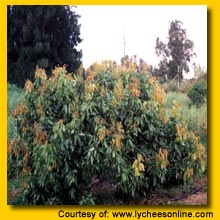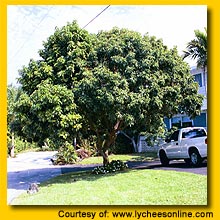|
Dec. 14, 2025
|
 ClimateGroff provided a clear view of the climatic requirements of the lychee. He said that it thrives best in regions "not subject to heavy frost but cool and dry enough in the winter months to provide a period of rest." In China and India, it is grown between 15° and 30° N. "The Canton delta ... is crossed by the Tropic of Cancer and is a subtropical area of considerable range in climate. Great fluctuations of temperature are common throughout the fall and winter months. In the winter sudden rises of temperature will at times cause the lychee ... to flush forth ... new growth. This new growth is seldom subject to a freeze about Canton. On the higher elevations of the mountain regions which are subject to frost the lychee is seldom grown . . . The more hardy mountainous types of the lychee are very sour and those grown near salt water are said to be likewise. The lychee thrives best on the lower plains where the summer months are hot and wet and the winter months are dry and cool."
Heavy rain or fog during the flowering period is detrimental, as are hot, dry, strong winds which cause shedding of flowers, also splitting of the fruit skin. Splitting occurs, too, during spells of alternating rain and hot, dry periods, especially on the sunny side of the tree. Spraying with Ethephon at 10 ppm reduced splitting in 'Early Large Red' in experiments in Nepal. SoilThe lychee grows well on a wide range of soils. In China it is cultivated in sandy or clayey loam, "river mud", moist sandy clay, and even heavy clay. The pH should be between 6 and 7. If the soil is deficient in lime, this must be added. However, in an early experiment in a greenhouse in Washington, D.C., seedlings planted in acid soil showed superior growth and the roots had many nodules filled with mycorrhizal fungi. This caused some to speculate that inoculation might be desirable. Later, in Florida, profuse nodulation was observed on roots of lychee seedlings that had not been inoculated but merely grown in pots of sphagnum moss and given a well-balanced nutrient solution.
The Chinese often plant the lychee on the banks of ponds and streams. In low, wet land, they dig ditches 10 to 15 ft (3-4.5 m) wide and 30 to 40 ft (9-12 m) apart, using the excavated soil to form raised beds on which they plant lychee trees, so that they have perfect drainage but the soil is always moist. Though the lychee has a high water requirement, it cannot stand water-logging. The water table should be at least 4 to 6 ft (1.2-1.8 m) below the surface and the underground water should be moving inasmuch as stagnant water induces root rot. The lychee can stand occasionally brief flooding better than citrus. It will not thrive under saline conditions.
For more information about our company and product lines, please go to:
www.iTitropicals.com.
Also, for detailed information on samples and
specifications please visit
www.iTitropicalscom.
|
| Voice: +1 609 987 0550 | Copyright 2025, iTi Tropicals, Inc. |
Fax: +1 609 482 4333 |

 Heavy frosts will kill young trees but mature trees can withstand light frosts. Cold
tolerance of the lychee is intermediate between that of the sweet orange on one hand
and mango and avocado on the other. Location, land slope, and proximity to bodies of
water can make a great difference in degree of damage by freezing weather. In the severe
low temperature crisis during the winter of 1957-58, the effects ranged from minimal to
total throughout central and southern Florida. A grove of 12-to 14-year-old trees south
of Sanford was killed back nearly to the ground; on Merritt Island trees of the same age
were virtually undamaged, while a commercial mango planting was totally destroyed.
L.B. Singh resists the common belief that the lychee needs winter cold spells that
provide periods of temperature between 30° and 40° F (-1.11° and 4.44° C) because
it does well in Mauritius where the temperature is never below 40° F (-1.11° C).
However, lychee trees in Panama, Jamaica, and other tropical areas set fruit only
occasionally or not at all.
Heavy frosts will kill young trees but mature trees can withstand light frosts. Cold
tolerance of the lychee is intermediate between that of the sweet orange on one hand
and mango and avocado on the other. Location, land slope, and proximity to bodies of
water can make a great difference in degree of damage by freezing weather. In the severe
low temperature crisis during the winter of 1957-58, the effects ranged from minimal to
total throughout central and southern Florida. A grove of 12-to 14-year-old trees south
of Sanford was killed back nearly to the ground; on Merritt Island trees of the same age
were virtually undamaged, while a commercial mango planting was totally destroyed.
L.B. Singh resists the common belief that the lychee needs winter cold spells that
provide periods of temperature between 30° and 40° F (-1.11° and 4.44° C) because
it does well in Mauritius where the temperature is never below 40° F (-1.11° C).
However, lychee trees in Panama, Jamaica, and other tropical areas set fruit only
occasionally or not at all.
 The lychee attains maximum growth and productivity on deep alluvial loam but flourishes
in extreme southern Florida on oolitic limestone providing it is put in an adequate
hole and irrigated in dry seasons.
The lychee attains maximum growth and productivity on deep alluvial loam but flourishes
in extreme southern Florida on oolitic limestone providing it is put in an adequate
hole and irrigated in dry seasons.
